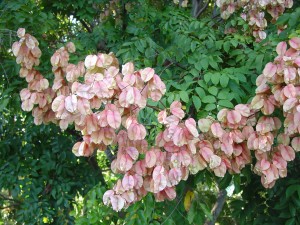Chinese flametree (Koelreuteria bipinnata) is also called bougainvillea raintree. This rare tree, available primarily from internet nursery commerce, deserves to be planted more. It has performed well in the Southern Appalachian region (USDA zones 6-b and 7) and is questionably hardy further north.
Flametree is less popular in Southeastern landscapes than goldenrain tree (K.paniculata). Low branching and broad canopy limits its landscape use to a small 25-30 foot tall specimen tree. Very showy dense terminal panicles of small fragrant yellow flowers appear in mid- to late summer, nearly 3-4 weeks after goldenrain tree (K.paniculata).
Large clusters of two-inch-long showy rose-colored “Chinese lanterns” form quickly after flowering which persist to mid-October. The papery thin seed husks retain their pink color indoors in dry flower arrangements. The bark on Chinese Flame-Tree is smooth and light brown when young, becoming more ridged or furrowed as the tree matures.
Flametree’s dark green summer compound leaves, each 1-2 feet long, turn yellow for a short autumn interlude before falling. Later, numerous fertile seeds drop, which potentially, may raise invasive issues for this species.
(See also blog on Goldenrain tree (K. paniculata) published 7-1 -11)


 Posted in
Posted in 
